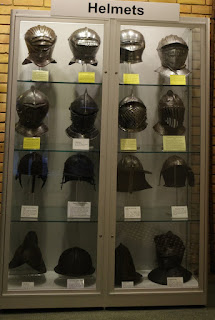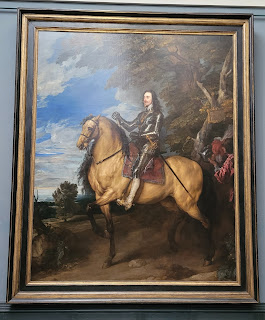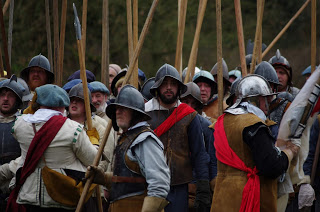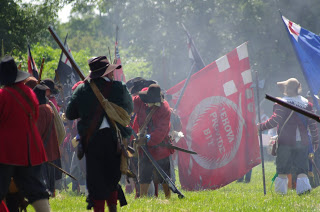Colonel Ruari McGuire's Regiment of Foot
I started this blog many moons ago as a repository for all the little bits of paper I wrote to myself... coat and flag colours, base sizes, paint colours, basing routine and so on. As I think I have finally worked out a way of drilling Irish hands that doesn't result in having to remake hands from Milliput, here's a note to myself, and anyone else who orders Peter Pig's Irish pike, when they meant to order Irish pike open hand:-
Pikemen legs wide apart: trim away pike, including between the hands. Then gently cut a notch in the back of both hands, smooth and widen 'hole' for pike with round file. Place pike in position then push foot of pike into a 'better' position.
Pikemen legs apart (the slightly more difficult one): cut away pike (including between the hands), careful of sword guard, make sure that the cut below the bottom hand is square; start drilling upwards from the cuff. Top hand cut and file a groove.
Pikemen legs together: trim away pike, leave pike between hands. Drill lower hand from underneath, cut notch in upper hand then drill, finally cutting away between the hands.
Oh, and what ever you do, don't forget - do a batch of three or four then have a break. Don't think that because you are on a roll, that you have suddenly become a god-like genius at hand drilling.
 |
Ruari, often written as Rory (I've even seen it anglicised as Roger) was born in 1619; he was the second son of Brian Roe, Lord McGuire (often Maguire) of Enniskillen.
The McGuires had been rewarded with land in the Ulster plantation thanks to supporting the government in the Nine Years War. Ruari was commissioned by Charles I as a captain in the Irish army in 1640, and elected MP for County Fermanagh in 1640–41.
Despite the family's favoured treatment as ‘deserving Irish’, and their cordial relations with protestant settlers, Ruari and his brother Conor, second Lord McGuire, were influential in the complex conspiracy which led to the outbreak of rebellion in the north of Ireland on 23 October 1641.
Conor's role was to lead an attack on Dublin Castle; but he was arrested, packed off to the Tower of London, and eventually executed in 1645. Ruari's task was to take control of Fermanagh and capture its strategically important fortresses.
But word got out and the protestant settlers under the command of Sir William Cole were able to hole up in the castles of Enniskillen and Ballyshannon. Ruari was left in command of the open countryside.
 |
Ó Néill and McGuire would join forces again, to try unsuccessfully, to take Augher fort in Tyrone with the aid of a siege gun brought by Maguire from Fermanagh. In December 1641, the Fermanagh army under McGuire slaughtered many of the garrison and refugees in Tully Castle, which had yielded on quarter, apparently in retaliation for the killing of the garrison of a McGuire held castle which had been taken by assault some days previously.
Early 1642 McGuire was appointed governor of Fermanagh and by the summer he was commissioned as a colonel in Eoghan Ruadh Ó Néill's Ulster Army, and raised his Regiment of Foot. McGuire, and his regiment would campaign mainly in Fermanagh and Monaghan. Campaign, perhaps being a little over egging of the pudding, looting and pillaging the surrounding area might be a more appropriate description.
Strangely things in Ireland went quiet until late 1645. Can't for the life of me think why...
With the cessation of hostilities in England in autumn 1645, Ó Néill ordered Ruari with 500 men to raid and plunder the English and Scots garrisons on the upper Lough Erne. Naturally his Regiment of Foot accompanied him. However, as he returned, Maguire was overtaken by English forces at Lowtherstown and was forced to abandon his plunder.
In 1646 he commanded the reserve at Benburb, leading it against the Scots’ collapsing right flank to complete the encirclement of the Scottish army and to precipitate its destruction. After Benburb, McGuire led raids in east Ulster, before joining Ó Néill in his campaigns in Leinster in the autumn of 1646.
As Ó Néill's relationship with the supreme council of the Catholic Confederation broke down in late 1646, McGuire was sent to secure Athlone for the Ulster army. Finding it in safe hands, he led his detachment into Connaught where he raided the lands of the Marquess of Clanricarde. He campaigned under Ó Néill in Connaught for much of 1647.
In August 1647 Ó Néill was ordered to return to Leinster to protect the province from protestant attacks. Reluctantly, Ó Néill agreed and set up camp in Kilbeggan, where he and Ruari began recruiting troops and gathering resources for the upcoming campaign.
McGuire and Ó Néill argued over the payment of troops, and Ó Néill ordered Ruari's arrest and court-martialled. Many of Ó Néill's men distrusted the Supreme Council and were very unhappy at Ó Néill's decision to return to Leinster. This issue, rather than money, was probably the real reason for McGuire's dispute with Ó Néill. During the court martial many officers in the Ulster Army took the stand to denounce the Supreme Council.
 |
The Ulster army campaigned for the supreme council in Leinster in the autumn of 1647, but in the summer of 1648 Civil War broke out within the Confederation, with Ó Néill opposing the Supreme Council's truce with protestant forces. McGuire played a prominent role in the skirmishes and evasive manoeuvrings that occurred between the two sides in the midlands, taking Banagher in a surprise attack with his Regiment. That winter, the Ulster army withdrew to the north, where McGuire was killed in a minor skirmish at Jamestown, County Leitrim.
The Regiment appear to have quietly been disbanded after Jamestown, many of its men returning home, whilst others were subsumed into other regiments.
Clothing colours are based upon Sir J T Gilbert's (History of the Irish Confederation and the War In Ireland 1641-1643) description of the Confederates fighting at Kilrush being almost indistinguishable from the bog due to the dark colours they wore.
There is no known regimental colour for the regiment; however, a number of Irish Confederate flags are described, so I have randomly assigned one to the regiment.
 |
Quite a few headswaps here, and a few figures from the spares box to add some 'difference'. Custom casualty marker from Warbases. Flag, as always, from Maverick Models.
Update: since discovering the primary source material for the Catholic Confederacy flags (see here) I've reflagged the regiment. Here's what they look like now...















Authur Champion MP was a notorious moneylender and land speculator. I suspect the two activities were not unrelated and were undoubtedly factors in his killing.
ReplyDeleteThe Maguires had long been considered a learned family, sponsoring the arts and literature. Sir John Davies, the Attorney-General of Ireland, toured seized Maguire lands in 1607 and observed, ‘Generally the natives of this country are reputed the worst swordsmen in the north, being rather inclined to be scholars or husbandmen, than to be kern, or men of action’.
It makes me wonder what happened, over the next few decades, to encourage such a shift to such vicious activity.
Thanks for the additional info Dex
DeleteGreat looking unit. Another fascinating regimental history. Just when you thought it couldn’t get more complicated!
ReplyDeleteThank you for your kind words FoGH. Irish... complicated? This is one of the more straightforward regimental histories to research. I've been putting off the complicated ones!
Delete